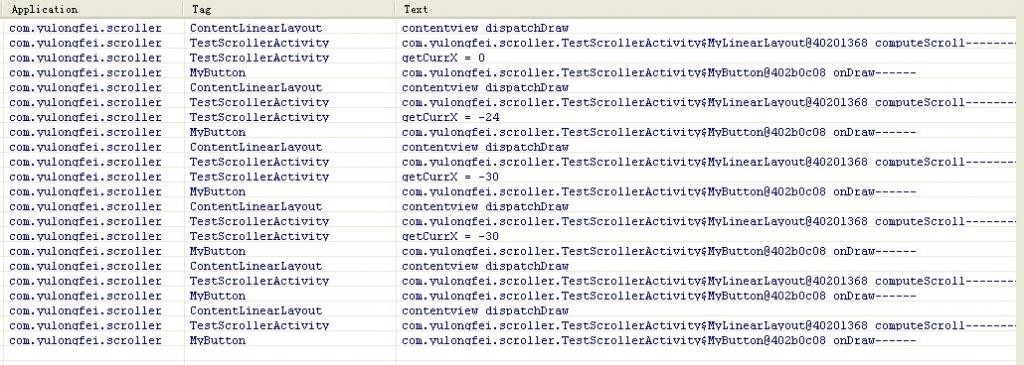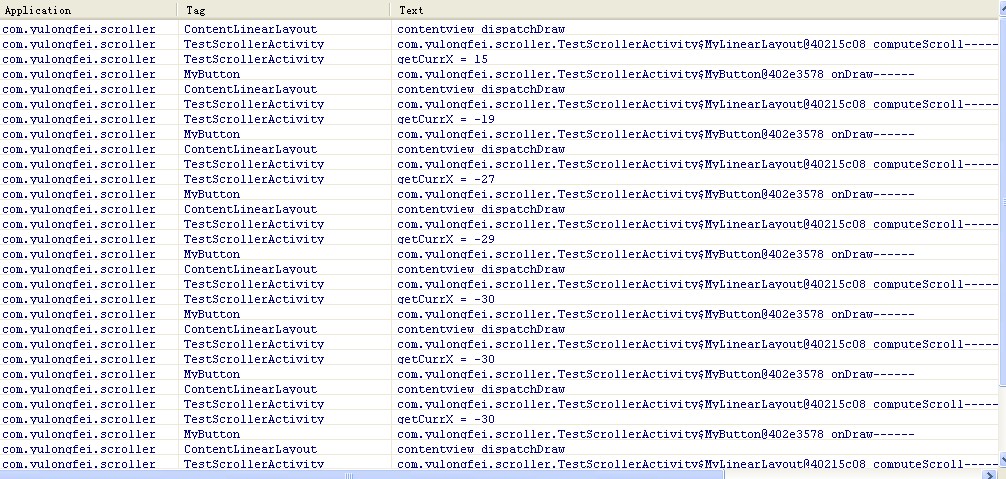Android Scroller类的详细分析
来源:互联网 发布:淘宝360无线手柄 编辑:程序博客网 时间:2024/04/29 09:37
尊重原创作者,转载请注明出处:
http://blog.csdn.net/gemmem/article/details/7321910
Scroller这个类理解起来有一定的困难,刚开始接触Scroller类的程序员可能无法理解Scroller和View系统是怎么样联系起来的。我经过自己的学习和实践,对Scroller的用法和工作原理有了一定的理解,在这里和大家分享一下,希望大家多多指教。
首先从源码开始分析:
View.java
/** * Called by a parent to request that a child update its values for mScrollX * and mScrollY if necessary. This will typically be done if the child is * animating a scroll using a {@link android.widget.Scroller Scroller} * object. */ public void computeScroll() { }
computeScroll是一个空函数,很明显我们需要去实现它,至于做什么,就由我们自己来决定了。
因为View的子类很多,在下面的例子中,我会在一个自定义的类MyLinearLayout中去实现它。
ViewGroup.java
@Override protected void dispatchDraw(Canvas canvas) { ....... ....... ....... ....... for (int i = 0; i < count; i++) { final View child = children[i]; if ((child.mViewFlags & VISIBILITY_MASK) == VISIBLE || child.getAnimation() != null) { more |= drawChild(canvas, child, drawingTime); } ....... ....... ....... }
从dispatchDraw函数可以看出,ViewGroup会对它的每个孩子调用drawChild(), 在下面的例子中, ContentLinearLayout的孩子有2个,是2个MyLinearLayout类型的实例。
再看看drawChild函数:
protected boolean drawChild(Canvas canvas, View child, long drawingTime) { ................ ................ child.computeScroll(); ................ ................}
看到这里,我想大家应该就明白了,在父容器重画自己的孩子时,它会调用孩子的computScroll方法,也就是说例程中的ContentLinearLayout在调用dispatchDraw()函数时会调用MyLinearLayout的computeScroll方法。
这个computeScroll()函数正是我们大展身手的地方,在这个函数里我们可以去取得事先设置好的成员变量mScroller中的位置信息、速度信息等等,用这些参数来做我们想做的事情。
看到这里大家一定迫不及待的想看代码了,代码如下:
package com.yulongfei.scroller; import android.widget.LinearLayout; import android.widget.Scroller; import android.app.Activity; import android.content.Context; import android.graphics.Canvas; import android.os.Bundle; import android.util.Log; import android.view.View; import android.widget.Button; import android.view.View.OnClickListener; import android.view.animation.DecelerateInterpolator; public class MainActivity extends Activity { private static final String TAG = "TestScrollerActivity"; LinearLayout lay1,lay2,lay0; private Scroller mScroller; @Override public void onCreate(Bundle savedInstanceState) { super.onCreate(savedInstanceState); mScroller = new Scroller(this, new DecelerateInterpolator(2.0F)); lay1 = new MyLinearLayout(this); lay2 = new MyLinearLayout(this); lay1.setBackgroundColor(this.getResources().getColor(android.R.color.darker_gray)); lay2.setBackgroundColor(this.getResources().getColor(android.R.color.white)); lay0 = new ContentLinearLayout(this); lay0.setOrientation(LinearLayout.VERTICAL); LinearLayout.LayoutParams p0 = new LinearLayout.LayoutParams (LinearLayout.LayoutParams.FILL_PARENT,LinearLayout.LayoutParams.FILL_PARENT); this.setContentView(lay0, p0); LinearLayout.LayoutParams p1 = new LinearLayout.LayoutParams (LinearLayout.LayoutParams.FILL_PARENT,LinearLayout.LayoutParams.FILL_PARENT); p1.weight=1; lay0.addView(lay1,p1); LinearLayout.LayoutParams p2 = new LinearLayout.LayoutParams (LinearLayout.LayoutParams.FILL_PARENT,LinearLayout.LayoutParams.FILL_PARENT); p2.weight=1; lay0.addView(lay2,p2); MyButton btn1 = new MyButton(this); MyButton btn2 = new MyButton(this); btn1.setText("btn in layout1"); btn2.setText("btn in layout2"); btn1.setOnClickListener(new OnClickListener(){ @Override public void onClick(View v) { mScroller.startScroll(0, 0, -200, 0, 500); } }); btn2.setOnClickListener(new OnClickListener(){ @Override public void onClick(View v) { mScroller.startScroll(0, 0, -300, 0, 600); } }); lay1.addView(btn1); lay2.addView(btn2); lay0.setLayerType(View.LAYER_TYPE_HARDWARE, null); lay1.setLayerType(View.LAYER_TYPE_SOFTWARE, null); lay2.setLayerType(View.LAYER_TYPE_SOFTWARE, null); } class MyButton extends Button { public MyButton(Context ctx) { super(ctx); } @Override protected void onDraw(Canvas canvas) { super.onDraw(canvas); Log.d("MyButton", this.toString() + " onDraw------"); } } class MyLinearLayout extends LinearLayout { public MyLinearLayout(Context ctx) { super(ctx); } @Override /** * Called by a parent to request that a child update its values for mScrollX * and mScrollY if necessary. This will typically be done if the child is * animating a scroll using a {@link android.widget.Scroller Scroller} * object. */ public void computeScroll() { Log.d(TAG, this.toString() + " computeScroll-----------"); if (mScroller.computeScrollOffset())//如果mScroller没有调用startScroll,这里将会返回false。 { //因为调用computeScroll函数的是MyLinearLayout实例, //所以调用scrollTo移动的将是该实例的孩子,也就是MyButton实例 scrollTo(mScroller.getCurrX(), 0); Log.d(TAG, "getCurrX = " + mScroller.getCurrX()); //继续让系统重绘 //postInvalidate(); } } } class ContentLinearLayout extends LinearLayout { public ContentLinearLayout(Context ctx) { super(ctx); } @Override protected void dispatchDraw(Canvas canvas) { Log.d("ContentLinearLayout", "contentview dispatchDraw"); super.dispatchDraw(canvas); } } } 对代码做一个简单介绍:
例子中定义了2个MyButton实例btn1和btn2,它们将被其父容器MyLinearLayout实例lay1和lay2通过调用scrollTo来移动。
ContentLinearLayout实例lay0为Activity的contentview,它有2个孩子,分别是lay1和lay2。
mScroller是一个封装位置和速度等信息的变量,startScroll()函数只是对它的一些成员变量做一些设置,这个设置的唯一效果就是导致mScroller.computeScrollOffset() 返回true。
这里大家可能有个疑问,既然startScroll()只是虚晃一枪,那scroll的动态效果到底是谁触发的呢?
后面我将给出答案。
运行程序,我们来看看Log
点击btn1:

点击btn2:
对照Log,我从button被点击开始,对整个绘制流程进行分析,首先button被点击(这里将回答上文的问题),button的背景将发生变化,这时button将调用invalidate()请求重绘,这就是View系统重绘的源头,即scroll动态效果的触发者。与此同时,mScroller.startScroll被调用了,mScroller在此时被设置了一些有效值。
好了,既然重绘请求已发出了,那么整个View系统就会来一次自上而下的绘制了,首先输出的Log就是“contentview dispatchDraw”了,它将绘制需要重绘的孩子(lay1和lay2中的一个),接着会调用drawChild,使得computeScroll函数被触发(drawChild里面会调用child.computeScroll()),于是,lay1或者lay2就会以mScroller的位置信息为依据来调用scrollTo了,它的孩子btn1或者btn2就会被移动了。之后又调用了getChildAt(0).invalidate(),这将导致系统不断重绘,直到startScroll中设置的时间耗尽mScroller.computeScrollOffset()返回false才停下来。
好了,现在整个流程都分析完了,相信大家应该清楚了Scroller类与View系统的关系了吧。理解了Scroller的工作原理,你会发现原来Scroller类并不神秘,甚至有点被动,它除了储存一些数值,什么其他的事情都没做,Scroller类中的一些变量mStartX, mFinalX, mDuration等等的意义也很好理解。
- Android Scroller类的详细分析
- Android Scroller类的详细分析
- Android Scroller类的详细分析
- Android Scroller类的详细分析
- Android Scroller类的详细分析
- Android Scroller类的详细分析
- Android Scroller类的详细分析
- Android Scroller类的详细分析
- Android Scroller类的详细分析
- Android中Scroller类的详细分析
- Android Scroller类的详细分析
- Android Scroller类的详细分析
- Android Scroller类的详细分析
- Android Scroller类的详细分析
- Android Scroller类的详细分析
- Android Scroller类的详细分析
- Android中Scroller类的分析
- Android中Scroller类的分析
- win7命令行卸载ie9,还原到ie8
- encode decode学习心得
- android屏幕旋转
- Android系统在超级终端下必会的命令大全(adb shell命令大全)
- Java Socket实战之五 使用加密协议传输对象
- Android Scroller类的详细分析
- Windows CE: LoadLibrary Fails with Error Code 193
- 从hello world 说程序运行机制
- win7 下硬盘安装fedora16
- ruby环境搭建
- 第三周 任务二
- 关于在case语句中变量的定义
- Nginx部署rails项目要点,大文件上传设置(413)
- 第二周实验报告(1)


